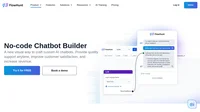What Is A ChatGPT with Internal Knowledge Flow
The Internal Document Search Integration Flow links OpenAI’s ChatGPT 4.0 with your organization’s internal documents. This feature enables ChatGPT to use information from your knowledge base to give detailed and contextually accurate responses. It’s especially beneficial for enhancing customer support, improving knowledge retrieval, and aiding internal teams in making informed decisions.
Features Of An ChatGPT with Internal Knowledge Flow
- Document Access Configuration: Configure access to your internal documents easily with tools like the Document Retriever.
- Query-Based Search: Enter queries that prompt the chatbot to find relevant documents.
- Contextual Responses: Provides answers using data from retrieved documents.
- Real-Time Interaction: Offers quick responses, generally within 10-15 seconds.
- Organizational Tips: Offers advice on maintaining current and well-organized documents.
Benefits Of An Internal ChatGPT with Internal Knowledge Flow
- Improved Efficiency: Makes information retrieval faster, aiding quicker decision-making.
- Enhanced Customer Support: Delivers precise and context-aware responses to client queries.
- Knowledge Management: Utilizes existing documents to inform responses, as highlighted in the Documents feature.
- Increased Productivity: Cuts down the time spent manually searching for information.
- Scalability: Integrates seamlessly with existing documentation systems.
Why Use Internal ChatGPT with Internal Knowledge
This flow allows organizations to better utilize their existing documentation. By integrating ChatGPT with internal documents, businesses can ensure their customer support teams provide accurate information without extensive manual searches. It also supports internal teams by being a reliable information source, facilitating quicker and more informed decision-making. This flow is particularly advantageous for companies with large knowledge bases, as it unlocks the potential of stored information, making it accessible and useful for daily operations.
Example Of Good And Bad Interactions
Good Example
User Input:
“How can I update my account details?”
Bot Output:
“To update your account details, go to the profile section on the dashboard and click ‘Edit Profile.’ You can find more detailed steps in our user guide under section 3.2.”
Analysis:
This example is effective because the bot provides a clear and concise response that directly addresses the user’s query. It directs the user to the exact location where the task can be accomplished (‘profile section on the dashboard’) and provides additional resources (‘user guide under section 3.2’) for further detailed instructions. By doing so, it not only answers the immediate question but also empowers the user with knowledge to explore further if needed.
Key Takeaways
- Provides direct and actionable steps.
- References additional resources for comprehensive guidance.
- Enhances user empowerment and independence.
Bad Example
User Input:
“How can I update my account details?”
Bot Output:
“You may find account settings somewhere in your profile, try looking for edit options.”
Analysis:
The response is vague and lacks specificity. It does not provide a clear path or specific instructions for the user to follow. The phrase “you may find” indicates uncertainty, which can lead to user frustration. Additionally, the lack of reference to structured documentation or specific sections makes it less useful, as it leaves the user without concrete next steps.
Key Takeaways
- Lacks specificity and clarity.
- Does not provide actionable guidance.
- Creates potential user frustration due to uncertainty.
By comparing these two examples, it’s evident that well-structured and specific responses greatly enhance the user experience, providing clarity and actionable steps, while vague responses can lead to confusion and dissatisfaction.
Who can use the “ChatGPT with Internal Knowledge” Flow?
The “ChatGPT – Internal Document Search Integration” flow is ideal for businesses and teams looking to enhance their internal support and knowledge retrieval processes. This flow is tailored for customer support agents, knowledge management teams, and internal assistance staff who need quick and accurate access to structured internal documentation. By leveraging OpenAI’s ChatGPT-4, users can input queries, and the bot will efficiently search through internal documents to provide precise, context-rich responses. To maximize its effectiveness, ensure that documents are well-organized and regularly updated. This flow not only enhances customer service interactions but also facilitates internal team collaboration by delivering informed answers swiftly.
Other Tools Similar To This Flow
- Microsoft Azure Cognitive Search:
- A cloud search service that provides powerful and sophisticated search capabilities for your apps. It allows you to index and search your internal documents with advanced AI capabilities.
- Learn more about Azure Cognitive Search
- Algolia:
- A hosted search API that provides fast and powerful relevance-based search to your internal documents. Algolia is known for its speed and flexibility in managing search results.
- Explore Algolia here
- Elasticsearch:
- A distributed, RESTful search and analytics engine capable of providing real-time search and data analysis for your internal documents. It’s widely used for its scalability and flexibility.
- Discover Elasticsearch
- Amazon Kendra:
- An intelligent search service powered by machine learning that makes it easy to integrate search capabilities for your internal documents. It’s part of the AWS ecosystem.
- Find out more about Amazon Kendra
- Lucidworks Fusion:
- A data discovery and search platform that integrates AI to enhance search capabilities for your internal documents. It offers machine learning-driven search relevance and analytics.
- Visit Lucidworks Fusion
These tools offer robust search and integration capabilities similar to the Flowhunt.io template, providing enhanced search experiences for internal document management and retrieval.
ChatGPT with Internal Knowledge
Integrate ChatGPT-4o with your docs for precise, context-rich support. Boost customer service and team efficiency. Try it now!



